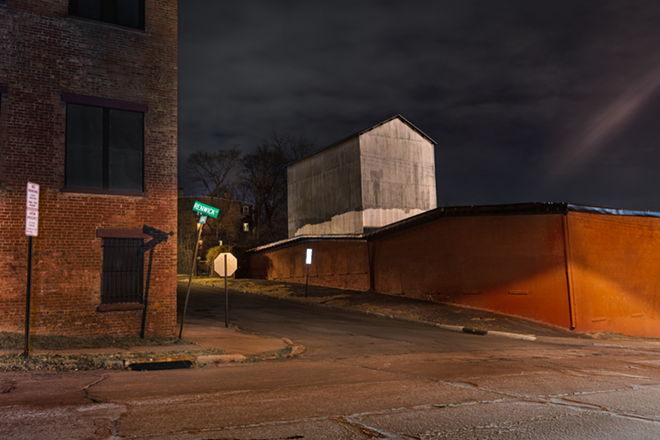Since half of our days either consist of blinding daylight or equally blinding darkness, there’s something about those precious few hours of “in between” when the light is either creeping in or falling from the sky. Photographer Lynn Saville has devoted her career to capturing these mystical times of the day in her moody solo show at the Florida Museum of Photographic Arts, aptly named Dark City.
Using abandoned buildings, construction sites and the occasional interior space as her subjects, Saville approaches urban photography from the angle of a portrait photographer, capturing the essence of these places. Just as you might try to take selfies in low lighting to get your best angle and soften out facial features, the artist uses the sexiest parts of the day — twilight and dawn — to bring out the seduction of the city.
Temperature contrasts between warmth and coolness from different light sources give many of the images strong reddish or bluish hues as their primary colors. “Parking Garage, Houston” perfectly sums up the idea that all blues are not created equal: A garage that most likely bustles with activity during the day is now inactive, with aqua-tinted LEDs blending into blue-purples and hints of pale yellows bouncing across the barren concrete floors. In a way, this is a photographer’s version of a painting palette, exploring and exposing the nuances of color in the nighttime.
There’s something sultry about architectural lines that intersect each other combined with the warmth from a streetlight hitting a reddish brown wall in “Warehouse, Newburgh,” yet a strangeness from the windowless buildings that close themselves off from the outside world. Though Saville’s main artistic interest lies in the basics of photography — line, form, color and emphasis on light and shadows — there’s a conceptual thread of vacancy and shifting urban landscape that runs through her works.
Saville is not necessarily nostalgic or wistful about these closed (either for good or just for the night) places, but she perfectly evokes that mysteriousness of walking down a lonely street, when the hair on your arms starts to rise. She’s probably able to capture that feeling because she prefers to take her photographs alone, keeping one eye on the lookout for trouble while her other eye peers through her camera lens.
While many images rely on external light sources to bounce off walls and roads, many of the structures glow from within. The striking red of internal light coming from a window in “Dyckman Street, Red Hook, Brooklyn” looks like something out of a horror film, where you’re just waiting for a dark shadow holding a knife to creep across the clouded glass. Substituting narrative for ambiguity, the peculiarity of these architectural spaces is enlivened.
Only a few hints of human life can be found in her photographs, like in “The Green Hand, Portland, Maine.” Typically preferring longer exposures, Saville managed to catch an unsuspecting walker quickly passing through the alleys in a quick snapshot. With a sigh of relief, these moments of civilization are needed to help ground the otherwise apocalyptic-like scenes of emptiness. In “Girl on the High Line, New York City,” a child’s blurred, temporal figure makes its way across the train tracks next to a garden of hazy, glowing flowers. Only the architecture, our manmade monuments, stands tall and unshaken. Saville reveals through her photos how, on Earth, we are temporary and our footsteps end up as ghostly impressions upon the planet in the grand scheme of things.
The various cycles of change and renewal are apparent themes, but it’s especially impactful in her contrast of natural and man-made elements in “Brooklyn Bridge Park Construction.” In the center of the frame, a tree, backlit from a construction spotlight, throws branches full of yellow leaves across the development zone, which has left barely enough room it to live on. I don’t get the impression that Saville is asking a question about gentrification, or that she's giving her opinion on the continual roadwork and expansion of cities; she is simply setting (or capturing, rather) the stage.
Depending on if you’re a glass-half-empty or glass-half-full kind of person, either nothing good happens after dark or all good things happen in the middle of the night. For me, these photographs reminisce of that time of the day as the sun goes down where there’s a twist between the somberness of a day coming to a close, but the exhilaration of the impending night. This moment is full of potential because there’s a lingering excitement in waiting —for something — to happen.
Lynn Saville: Dark City
Through Nov. 20.
Florida Museum of Photographic Arts, 400 N. Ashley Dr., Cube 200, Tampa.
$8-$10.


